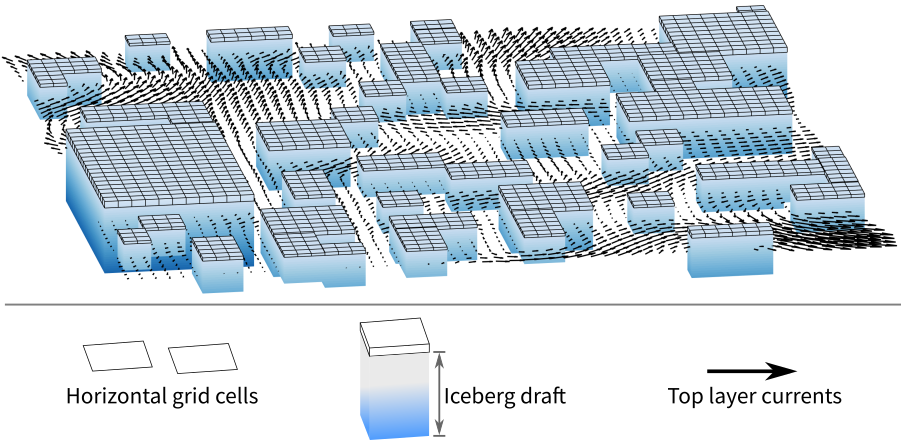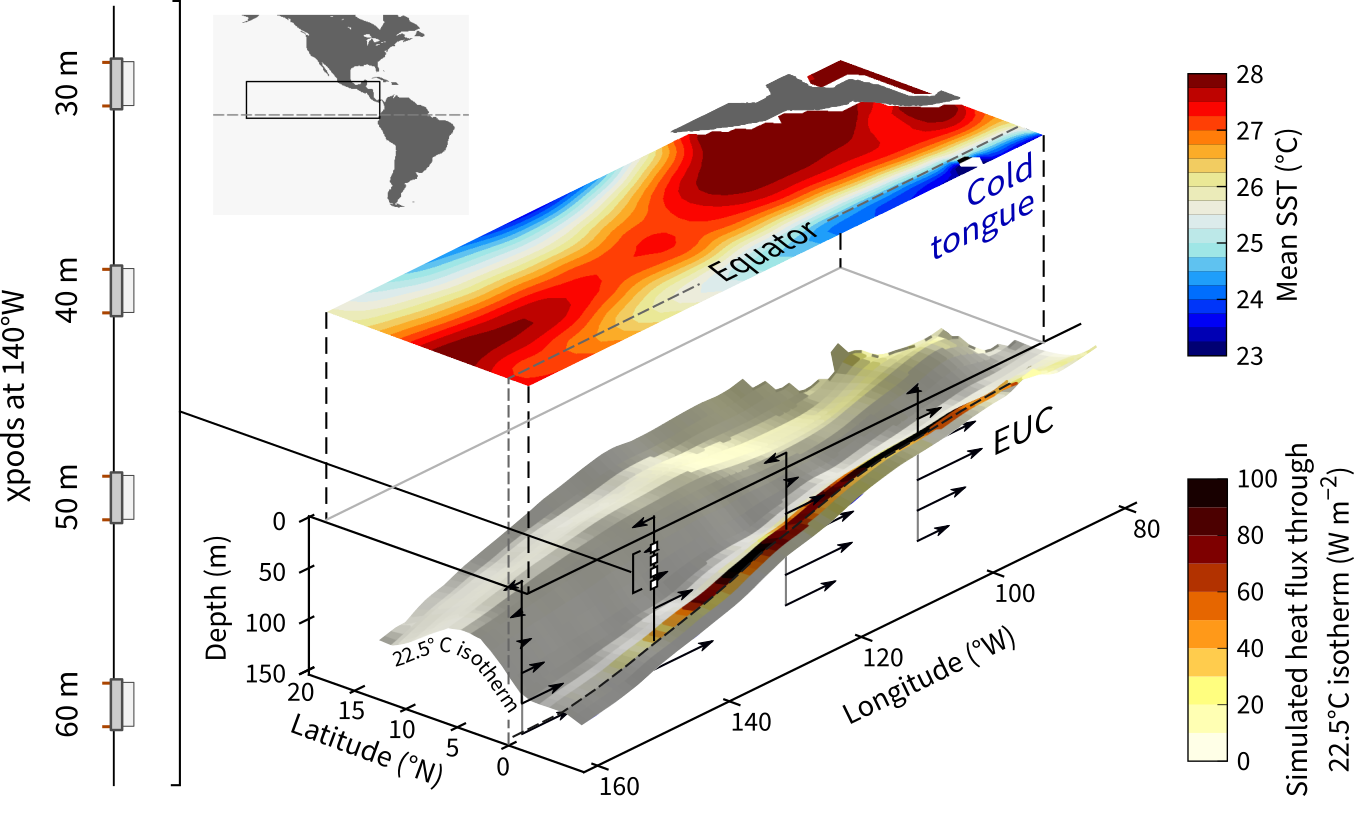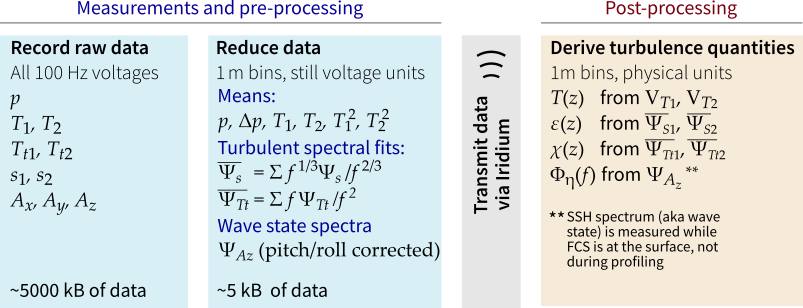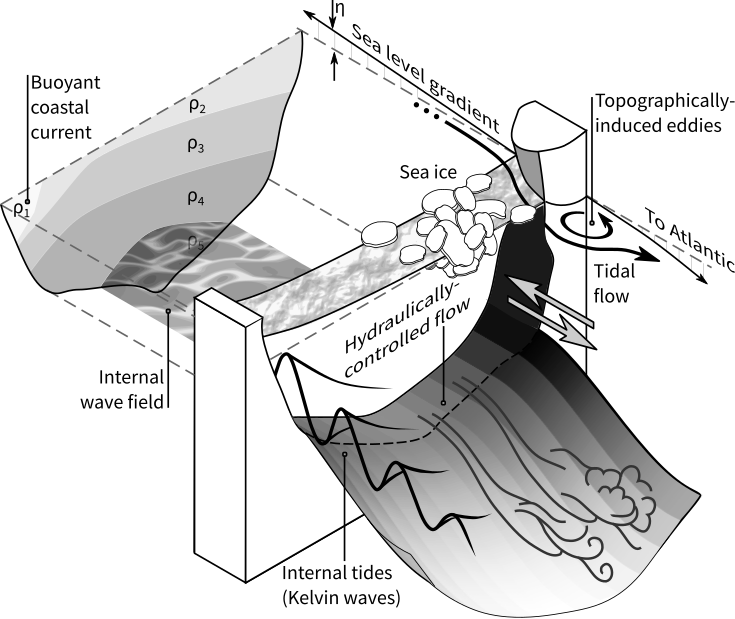Current and Past Research Projects
Oceanic flow in glacial fjords
At the head of many glacial fjords in Greenland is a mélange, a stiff matrix of icebergs and sea ice. Whether remotely forced ocean currents go under or around the icebergs is unclear, as is the role of currents generated locally by melting. I am addressing such questions using small-scale, three-dimensional modelling of the flow through a collection of thermodynamically active icebergs. The problem presents a large parameter space include the size, depth, and packing density of icebergs, the strength of stratification, and the incoming flow speeds.

An example of simulated flow through a densely packed mélange.
Mixing in equatorial cold tongues
Large amounts of heat are mixed downward to colder, deeper waters in the equatorial cold tongues in the Pacific and Atlantic Oceans. Turbulence here is known to influence large spatial and temporal scales and yet much remains unknown about the smallest scales. To better establish the link between scales, I am interpreting measurements from moored mixing meters (χpods) in concert with the observations of shear, stratification, and various co-evolving non-dimensional parameters such as the buoyancy Reynolds number.

Strong shear between the westward surface current and the equatorial undercurrent creates a narrow region of intense downward turbulent transfer of heat. Simulated fluxes based on Holmes et al. (2019).
Automating turbulence profiling measurements
Transmitting data such as temperature, pressure, conductivity, and position in real time is now commonplace with autonomous ocean profilers. Doing the same with raw turbulence measurements is not yet possible since data sampling rates are orders of magnitude too high. To address this issue, I am developing a scheme to reliably reduce turbulence data from a vertically profiling float. We plan to deploy autonomized turbulence profilers in experiments in 2023/2024.

An outline of the turbulence data reduction procedure.
Turbulence and shear in diurnal warm layers
Improved understanding of diurnal changes in the vertical distribution of heat and momentum of the upper ocean is necessary for better predictions of sea surface temperature, storms, and longer-term atmospheric variability such as monsoon cycles. It is challenging, however, to measure near-surface velocities and turbulence. Surface waves introduce errors into measurements from a fixed platform, prop wash and ship wake can ruin measurements above 5 m, and long time series are necessary to account for intermittent wave breaking events. My current research looks to quantify and understand near-surface dynamics such as shear and turbulence, with a particular focus on its diurnal evolution in the tropical ocean.

Variation of near-surface shear induced by a diurnal temperature gradient.
Stratified tidal flows in the Canadian Arctic
Large-scale volume and freshwater fluxes through the Canadian Arctic Archipelago are driven by differences in density and atmospheric pressure. These fluxes, however, are modulated by smaller-scale (metre to kilometre) phenomena such as internal waves, topographically induced eddies, and hydraulic jumps. Such small-scale processes were the focus of my PhD research. They are not resolved by large-scale circulation models or mesoscale surveys. I therefore undertook process-oriented studies to understand and quantify the cumulative effect of these unresolved motions. Techniques include numerical modelling of the flows, analysis of shipboard data, and interpretation in terms of channel-flow theories.

Many of the phenomena that play key roles in the Archipelago.
The Archipelago has complex but fascinating oceanography. To start, it is a meeting ground for waters from the Pacific, Arctic, and Atlantic Oceans. These waters flow through the many channels demarcated by a hundred major islands. While doing so, they encounter rough topography, strong tidal currents, and variable sea ice.
Ice–ocean interactions in McMurdo Sound
Sea ice in regions near an ice shelf may be thicker than otherwise expected due to supercooled water. Waters tens of millikelvin cooler than the freezing point are commonly observed flowing northward from beneath the Ross/McMurdo Ice Shelves. Within the supercooled plume are small frazil ice crystals. My MSc research considered the fate of these crystals: their growth rate while suspended, the distance they travelled before precipitating, the drag they induce after they consolidate, and their effect on interactions at the base of sea ice.

Supercooled water is produced as comparatively fresh water rises up beneath an ice shelf.
In related projects, I have
- interpreted the occurrence of platelet ice around Antarctica from numerous published and unpublished studies
- analysed anomalies in thermistor arrays as proxies for brine convection
- developed models of the growth of ice within a borehole melted through an ice shelf